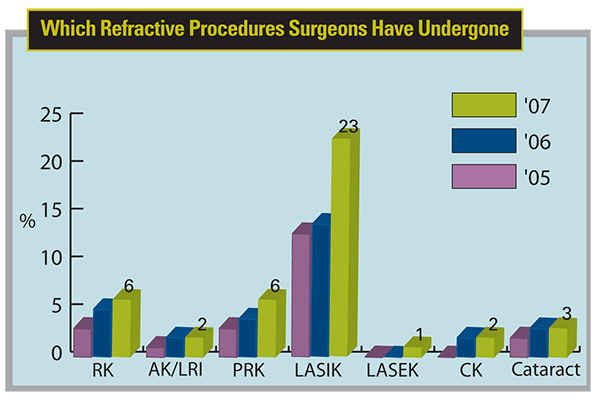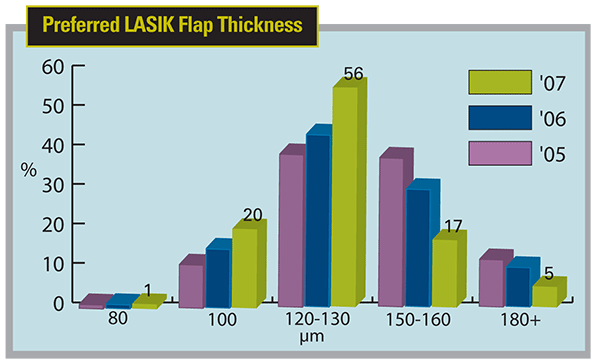The debate over whether or not to use custom ablations on every patient seems to be tipping in favor of the doctors who adhere to this practice, at least according to the most recent survey of the members of the American Society of Cataract and Refractive Surgery. One of the survey's co-authors, Richard Duffey, MD, of
LASIK Findings
Dr. Duffey says it appears surgeons are embracing custom ablations more than ever. Last year, approximately 25 percent of the respondents said they used wavefront-guided ablations for 76 to 100 percent of their patients. This year, however, the percentage who use them for this many patients shot up to 52 percent. Conversely, the percentage who use custom on 51 to 75 percent of their cases dropped from around 37 percent to just 11 percent this year.
"Fifty-two percent essentially do custom all the time, and that number continues to go up every year," avers Dr. Duffey. "It blipped down a little last year, but this year it really jumped up."
On the topic of ectasia, careful patient selection on the part of surgeons appears to be paying dividends in the postop course. "One thing that really jumped out at me is that the numbers for ectasia aren't going up," Dr. Duffey says. "That's reassuring." The percentage of surgeons who report having had a case of ectasia in their career decreased from 30 percent to 17 percent from last year to this year (presumably as new surgeons undertake LASIK and don't encounter ectasia). "I think we're more selective on whom we'll do LASIK," says Dr. Duffey. "I think in the late 1990s and even the early 2000s, it was kind of a 'come one, come all' atmosphere, and we weren't concerned about minor topographic changes or minimal corneal thicknesses. Now I think we'll usually err on the side of caution. Most cases of ectasia are going to occur within the first 12 to 24 months after the procedure, so it doesn't take long to see if changes to your surgical approach are reducing those numbers, so it's a good sign they're not increasing."
Along those lines, the minimum residual scleral bed thickness that surgeons report using is moving toward the thicker end of the scale. The percentage of surgeons who say they shoot for a residual bed of 300 µm increased from 12 to 17 percent since the last survey, while those who aim for 250 µm decreased from 61 to 57 percent. "Minimum bed thickness is drifting above 250 µm," says Dr. Duffey. "You can see that trend in the data. I think surgeons are realizing there's more variability in there. I know that, for myself, I used to say 250 µm, but now I aim for 300 µm, because I know if I get a little thicker flap than what I intended I'll have some extra cushion there.
"Also, I think the data supports the fact that we're starting to feel less comfortable with corneas that are thinner than 500 µm. It used to be at about 480 µm where people would draw the line on LASIK, but now I think people are tending to use surface ablation on patients with less than 500 µm of corneal thickness."
Another trend that's appearing is the use of thinner flaps. Last year, 30 percent of the respondents reported using flaps between 150 and 160 µm thick. This year, however, that number has dropped to 17 percent. On the rise are 120- to 130-µm flaps, done by 56 percent of surgeons vs. 45 percent last year and 37 percent the year before. Also rising in popularity are very thin—100-µm—flaps, now used by a fifth of the respondents, compared to just about 14 percent last year and only 10 percent the year before that. "It was five years ago that I discovered that very thin flaps have advantages, including less risk of ectasia, the ability to operate on a larger percentage of the population and faster recovery," says Dr. Duffey. "I use the IntraLase, but I mainly use a mechanical microkeratome, and find I can get the same good results with it as with the IntraLase. I still believe in getting as close to Bowman's as you can, safely, and that typically means using anywhere between an 80- and 100-µm flap when you can.
Countering LASIK's Detractors
Dr. Duffey feels the current U.S. Food and Drug Administration inquiry into the safety of LASIK is unnecessary, and says surgeons believe so strongly in the procedure that they're willing to put their eyes, and the eyes of their family, under the laser.
"I think it's really important to note the number of refractive surgeons in ASCRS who have had LASIK themselves in light of the investigation into LASIK that's been started in
To drive this point home, Dr. Duffey says next year's refractive surgery survey will also ask surgeons about their family members' history of laser vision correction. "I think you'll find that so many of the surgeons' spouses, children, siblings, in-laws and parents have had laser vision correction that you'll be astounded," he says. "At my practice, I've performed LASIK on my daughter, my brother, multiple brothers- and sisters-in-law, and others. Surgeons like me wouldn't do that if we weren't believers in the technology and what the surgery can accomplish in the right patients. In next year's survey, I don't think anything will speak louder about the value of the procedure than the total support of the people who do it. You never saw that type of support with radial keratotomy, but it's certainly been true with laser vision correction."







